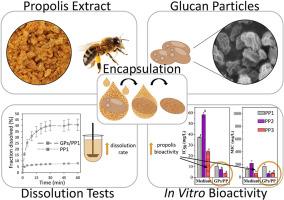酵母葡聚糖颗粒传递蜂胶提取物的体外生物活性评价
IF 4.9
3区 医学
Q1 PHARMACOLOGY & PHARMACY
Journal of Drug Delivery Science and Technology
Pub Date : 2025-09-05
DOI:10.1016/j.jddst.2025.107490
引用次数: 0
摘要
蜂胶由于其抗菌、抗癌和免疫调节的特性,被广泛应用于各种疾病的治疗。然而,其较差的水溶性和生物利用度降低了其在体内的有效性。通过将增强的蜂胶提取与将提取液装入合适的载体相结合,可以找到一种解决方案。在这里,我们研究了从面包酵母(Saccharomyces cerevisiae)细胞壁中获得的葡聚糖颗粒,作为有前途的多孔载体,能够增加蜂胶的分散,从而提高其溶解度。首先,采用改进的超声法(70%乙醇,蜂胶/乙醇比1:10)制备蜂胶提取物;采用不同产地和采收年份的三种原料蜂胶进行比较。接下来,通过喷雾干燥和浆液蒸发将冻干蜂胶提取物装入葡聚糖颗粒中,以确保得到的蜂胶提取物含量为10 wt %。ATR-FTIR和SEM证实了葡聚糖颗粒的成功装入,紫外-可见分光光度法测定了包封效率。溶出试验表明,葡聚糖颗粒的负载导致蜂胶提取物形成过饱和溶液,并提高了其溶出速率。随后,研究了胶囊化蜂胶提取物的生物活性。综上所述,蜂胶提取物的抗炎、抗氧化和抗菌活性明显高于纯蜂胶。因此,我们的研究结果表明,蜂胶提取物与葡聚糖颗粒的组合可以提高蜂胶的溶解度和生物活性。本文章由计算机程序翻译,如有差异,请以英文原文为准。

Evaluation of in vitro bioactivity profile of bee propolis extracts delivered by yeast glucan particles
Due to its antibacterial, anticancer and immunomodulatory properties, propolis is widely used in the treatment of various diseases. However, its poor water solubility and bioavailability reduce its effectiveness in vivo. A solution may be found by combining enhanced propolis extraction with loading the extract into a suitable carrier. Here, we investigated glucan particles, obtained from the cell walls of baker's yeast (Saccharomyces cerevisiae), as promising porous carriers capable of increasing the dispersion of propolis and, thereby, its solubility. First, propolis extracts were prepared using a modified sonication method (70 % ethanol at a propolis/ethanol ratio of 1:10); three types of raw propolis differing in source location and year of harvest were used for comparison. Next, lyophilized propolis extracts were loaded into the glucan particles by spray drying and slurry evaporation to ensure the resulting propolis extract content of 10 wt %. ATR-FTIR spectroscopy and SEM confirmed the successful loading into the glucan particles, and UV–VIS spectrophotometry was used to determine encapsulation efficiency. Dissolution tests showed that the loading into glucan particles led to the formation of a supersaturated solution of propolis extract and the enhancement of its dissolution rate. Subsequently, the biological activity of the encapsulated propolis extract was investigated. Overall, the encapsulated propolis extract showed much higher anti-inflammatory, antioxidant and antimicrobial activity than pure propolis. Thus, our results indicate that the combination of propolis extract with glucan particles increases propolis solubility and bioactivity.
求助全文
通过发布文献求助,成功后即可免费获取论文全文。
去求助
来源期刊
CiteScore
8.00
自引率
8.00%
发文量
879
审稿时长
94 days
期刊介绍:
The Journal of Drug Delivery Science and Technology is an international journal devoted to drug delivery and pharmaceutical technology. The journal covers all innovative aspects of all pharmaceutical dosage forms and the most advanced research on controlled release, bioavailability and drug absorption, nanomedicines, gene delivery, tissue engineering, etc. Hot topics, related to manufacturing processes and quality control, are also welcomed.

 求助内容:
求助内容: 应助结果提醒方式:
应助结果提醒方式:


